ICICI Prudential Balanced Advantage Fund: 10 years of Balanced Advantage Fund Model

The whole world is going through the worst crisis in several decades due to rapid spread of Coronavirus. Many countries including India are in lockdown and stock markets all over the world have crashed. The Sensex is down 35% this year, but there are many examples of severe market downturns in the past (see the chart below). Despite severe downturns, the Sensex has given around 14% CAGR return over the last 30 years (ending 29th February 2020).
You may like to read – Which is the best time to invest in mutual funds
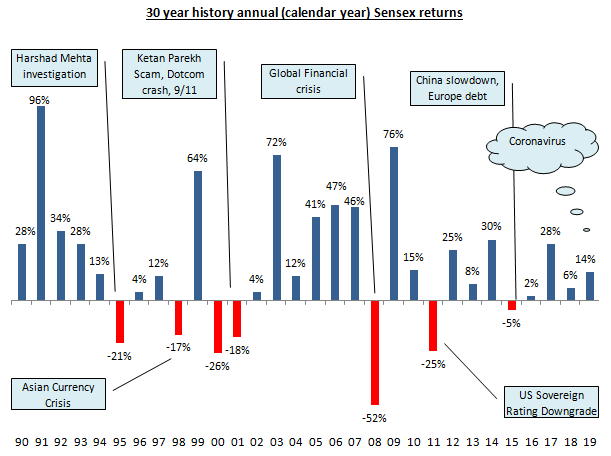
Source: Bombay Stock Exchange
Though equity is the best performing asset class in the long term, a severe correction can wipe out several years of gains. This recent crash has already taken us to Sensex levels in July – August 2014, wiping out 4.5 years of profits. Similarly, the stock market crash in 2008 wiped out nearly 3.5 years of profit made in the bull market years of 2005 – 07.
Suggested reading: Economic slowdown: Is it real and what should you do?
How can you protect your hard earned money from extreme volatility? When to buy and sell?
Buy low and sell high
The oldest stock market wisdom is buy low and sell high, but we often end up doing the exact opposite due to greed and fear. In a bull market, we hope that prices will go up even if they are high and buy at high prices (greed). Likewise in a bear market, we fear prices will fall, even after they have fallen a lot and sell at very low prices (fear). Even if you are able to control your own greed and fear, the most confusing question is to decide “when to enter and when to exit”? What is a low price and what is a high price of a stock? If you ask this question to 10 different people, you may get different answers. So what is the solution?
Dynamic Asset Allocation – Balanced Advantage Fund (BAF)
ICICI Prudential MF uses their Price to Book Value (P/BV) model to manage their asset allocation dynamically according to market conditions. The model enables ICICI Prudential Balanced Advantage Fund to buy low and sell high, keeping human emotions aside. How does P/BV DAA model work?
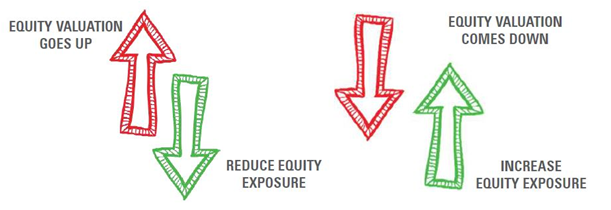
There are several hybrid mutual funds which uses different valuation measures for dynamic asset allocation, the most common being Price Earnings Ratio (P/E ratio), but P/BV based model has several advantages over P/E based dynamic asset allocation models:-
- P/BV is better equipped to gauging intrinsic value of a company
- Book value is a balance sheet item, thereby more reliable than P/E ratio
- P/BV is less volatile than P/E
How has BAF managed asset allocation in different market conditions?
ICICI Prudential Balanced Advantage Fund has managed equity allocation from 30% to 80% in different market conditions – the balance allocation is in fixed income (debt). The average monthly equity level over the last 10 years till 29th February 2010 was 55%. However, the scheme has increased its equity allocation to 70% this month (March 2020) following the recent market melt- down due to Coronavirus.
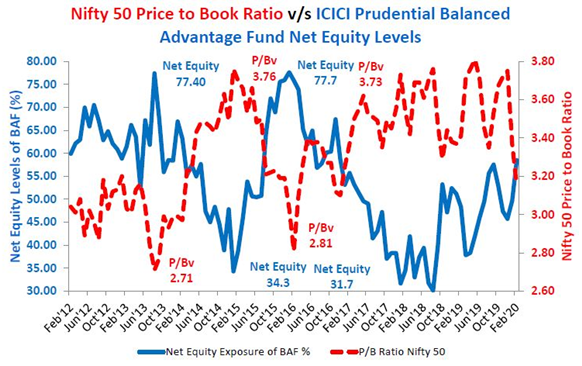
Source: ICICI Prudential MF
How BAF ensures equity taxation?
Equity funds enjoy a huge tax advantage over most asset classes. In the previous we saw that the average equity level of the BAF model over the last 10 years was 55%. In order to enjoy equity taxation, mutual funds need to have at least 65% allocation to equity. ICICI Prudential Balanced Advantage Fund ensures equity taxation while managing its active equity exposure through the use of derivatives.

Source: ICICI Prudential MF
How has BAF performed in different market conditions?
See the chart below, which shows 1 year return at the end of each quarter since Jun 2010 to Dec 2019. You can see that the scheme outperformed the market in falling and range-bound markets, often giving positive returns when market was down. In rising markets, the scheme has generally underperformed the market but has given good inflation adjusted returns. In the last 10 years (ending 29th February 2020), ICICI Prudential BAF has given 11.7% CAGR return while Nifty gave 9.7% return.
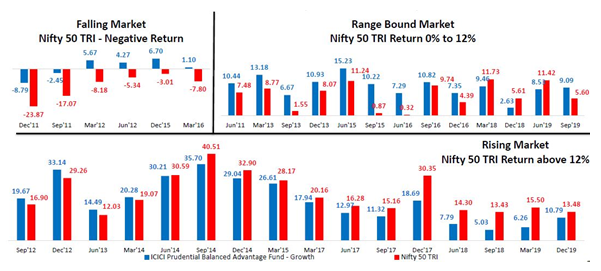
Source: ICICI Prudential MF
Rolling Returns
In bull markets, we often hear investors and financial advisors complaining that BAF not giving high returns. However, a performance of a hybrid scheme should be evaluated over a period which covers different market conditions – rising, falling and range bound markets. We have stated a number of times in our blog that rolling returns is most unbiased and hence the best measure of mutual fund performance. The chart below shows the 5 year rolling returns of ICICI Prudential Balanced Advantage Fund versus Sensex TRI over the last 10 years (ending 29th February 2020).
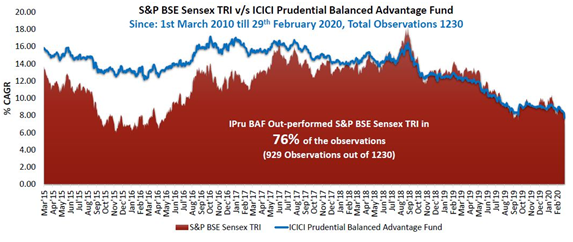
Source: ICICI Prudential MF
Wealth Creation by BAF
Most investors associate wealth creation with equity funds and think of BAF as a risk limiting investment. This is wrong perception. It is true that equity funds have higher wealth creation potential in certain point to point periods, but ICICI Prudential Balanced Advantage Fund also has strong wealth creation track record generating alphas over long investment periods despite much less risk (due to high average fixed income allocations).
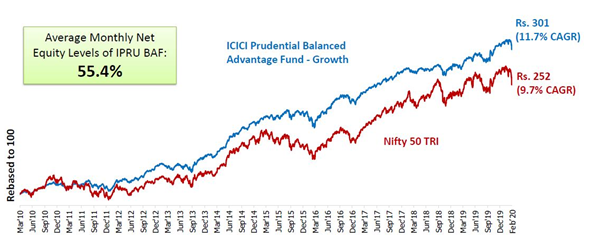
Conclusion
ICICI Prudential Balanced Advantage Fund has a strong 10 year track record. Limited down side volatility,superior risk adjusted and tax efficiency makes this fund an ideal investment choice for investors who do not have high risk appetite.
In our view, you should have at least 5 year investment horizon for this fund, but you can better results over a longer time-frame. Historical data shows that, you do not need to take excessive risk or extraordinarily high returns to achieve your financial goals. Astute asset allocation and disciplined investing over long periods of time are the key success factors in wealth creation. You should consult with your financial advisors if this fund is suitable for your investment needs.
We would also suggest readers to go through the following article –
Why you need to have hybrid mutual funds in your portfolio
Mutual Fund Investments are subject to market risk, read all scheme related documents carefully.
Queries
-
What is the benefit of mutual fund STP
Aug 29, 2019
-
How much to invest to meet target amount of Rs 2 Crores
Aug 26, 2019
-
Can I achieve my financial goals with my current mutual fund investments
Aug 24, 2019
-
Can you tell me return of various indices
Aug 19, 2019
-
What would be the post tax return on different investments
Aug 18, 2019
-
Which Principal Mutual Fund scheme will be suitable for my retirement corpus
Aug 16, 2019
-
What is the minimum holding period for availing NCD interest
Aug 4, 2019
Top Performing Mutual Funds
Recommended Reading
Fund News
-
Zerodha Mutual Fund launches Zerodha Nifty Short Duration G Sec Index Fund
Dec 26, 2025 by Advisorkhoj Team
-
Groww Mutual Fund launches Groww Nifty Chemicals ETF
Dec 26, 2025 by Advisorkhoj Team
-
DSP Mutual Fund launches DSP Nifty Next 50 ETF
Dec 19, 2025 by Advisorkhoj Team
-
DSP Mutual Fund launches DSP Nifty 500 Index Fund
Dec 19, 2025 by Advisorkhoj Team
-
Kotak Mahindra Mutual Fund launches Kotak Nifty Next 50 ETF
Dec 18, 2025 by Advisorkhoj Team














